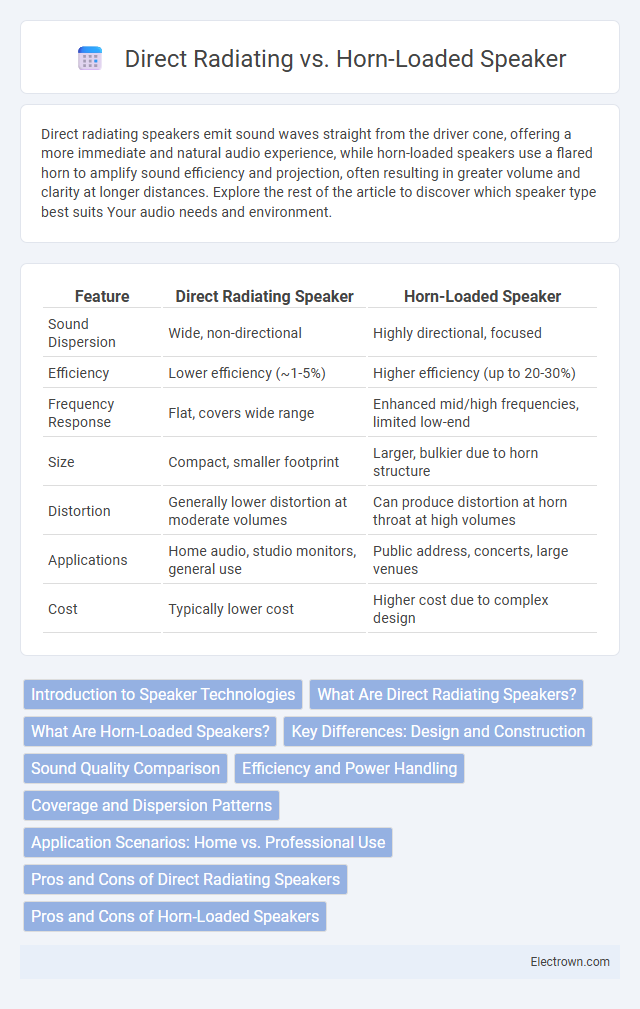Direct radiating speakers emit sound waves straight from the driver cone, offering a more immediate and natural audio experience, while horn-loaded speakers use a flared horn to amplify sound efficiency and projection, often resulting in greater volume and clarity at longer distances. Explore the rest of the article to discover which speaker type best suits Your audio needs and environment.
Table of Comparison
| Feature | Direct Radiating Speaker | Horn-Loaded Speaker |
|---|---|---|
| Sound Dispersion | Wide, non-directional | Highly directional, focused |
| Efficiency | Lower efficiency (~1-5%) | Higher efficiency (up to 20-30%) |
| Frequency Response | Flat, covers wide range | Enhanced mid/high frequencies, limited low-end |
| Size | Compact, smaller footprint | Larger, bulkier due to horn structure |
| Distortion | Generally lower distortion at moderate volumes | Can produce distortion at horn throat at high volumes |
| Applications | Home audio, studio monitors, general use | Public address, concerts, large venues |
| Cost | Typically lower cost | Higher cost due to complex design |
Introduction to Speaker Technologies
Direct radiating speakers produce sound by moving a diaphragm directly in front of the driver, delivering accurate and immediate audio response ideal for close listening environments. Horn-loaded speakers use a horn structure to amplify and efficiently project sound waves, enhancing sensitivity and extending sound dispersion over greater distances. This fundamental technological difference impacts power handling, frequency response, and application suitability in various acoustic settings.
What Are Direct Radiating Speakers?
Direct radiating speakers produce sound by moving the diaphragm directly, creating a straightforward and natural audio output. These speakers offer precise sound reproduction and typically have a simpler design compared to horn-loaded models. Your listening experience benefits from their accurate midrange and bass response, making them ideal for detailed music and home audio systems.
What Are Horn-Loaded Speakers?
Horn-loaded speakers use a flared horn structure to improve speaker efficiency and direct sound waves, enhancing projection and reducing distortion compared to direct radiating speakers. The horn design acoustically matches the speaker driver to the air, amplifying sound output while controlling dispersion for targeted sound delivery. This technology is prevalent in professional audio systems, providing higher sensitivity and greater sound pressure levels.
Key Differences: Design and Construction
Direct radiating speakers feature a simple design where the driver faces outward, producing sound waves directly into the listening environment, resulting in a more compact and versatile construction. Horn-loaded speakers utilize a flared horn structure attached to the driver, amplifying sound pressure and improving efficiency by matching acoustic impedance between the driver and air. The horn shape significantly influences sound dispersion and frequency response, offering greater control over directionality compared to the broader, more uniform radiation pattern of direct radiating designs.
Sound Quality Comparison
Direct radiating speakers deliver a more natural and accurate sound reproduction due to the driver's direct interaction with the air, offering tighter bass response and clearer midrange frequencies. Horn-loaded speakers increase efficiency and sound projection by using a flared horn, enhancing dynamic range and sensitivity, which can result in a more powerful and forward sound but may introduce coloration or horn-related resonances. Audiophiles often prefer direct radiators for critical listening environments while horn-loaded speakers excel in large spaces requiring higher sound pressure levels.
Efficiency and Power Handling
Horn-loaded speakers offer greater efficiency by using their shape to amplify sound waves, requiring less power to achieve higher volume levels compared to direct radiating speakers. Direct radiating speakers handle power more linearly, often delivering more consistent performance across a broad frequency range but typically at lower efficiency. If you seek maximum output with less amplifier power, your choice should lean toward horn-loaded designs for superior efficiency, while direct radiating models suit environments valuing tonal accuracy and moderate power handling.
Coverage and Dispersion Patterns
Direct radiating speakers offer a wide and uniform coverage pattern, making them ideal for consistent sound distribution in smaller to medium-sized venues. Horn-loaded speakers provide controlled dispersion with a narrower, more focused sound projection, enhancing efficiency and reducing sound reflections in larger or outdoor environments. The choice between these designs depends on the desired coverage area and acoustic environment.
Application Scenarios: Home vs. Professional Use
Direct radiating speakers excel in home environments due to their compact design and balanced sound profile, making them ideal for casual listening and smaller rooms. Horn-loaded speakers are preferred in professional settings like concerts and auditoriums, offering higher efficiency and greater sound projection to cover large audiences effectively. Choosing between these types depends on the required sound coverage, with direct radiating suited for intimate spaces and horn-loaded optimized for expansive venues.
Pros and Cons of Direct Radiating Speakers
Direct radiating speakers offer a compact design and often deliver a natural, accurate sound reproduction with a more straightforward frequency response compared to horn-loaded speakers. They tend to have less efficiency and require more power to achieve high volume levels, which may limit their effectiveness in very large venues. Your choice may depend on whether you prioritize precise audio fidelity or the higher efficiency and projection ability found in horn-loaded models.
Pros and Cons of Horn-Loaded Speakers
Horn-loaded speakers offer high efficiency and enhanced directional control, making them ideal for large venues and outdoor use where sound needs to travel long distances with minimal distortion. They commonly exhibit a focused dispersion pattern, which reduces sound spillage and improves clarity but can limit sound coverage in smaller or irregularly shaped rooms. However, horn-loaded designs tend to be bulkier and can introduce coloration or unnatural tonal characteristics compared to direct radiating speakers, which promote a more natural and balanced sound reproduction.
direct radiating vs horn-loaded speaker Infographic

 electrown.com
electrown.com